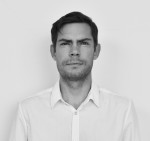Gabriel Fries-Briggs, UCLA’s 2014-2015 Department of Architecture and Urban Design teaching fellow, led a seminar during winter quarter that opened a forum for undergraduate students to create art out of architectural problems involving plumbing, insulation and wall sections.
Michael Osman, assistant professor in the architecture and urban design department, said Fries-Briggs’ “X Between Assembly and Composition” seminar was risky and advanced because it involved bringing undergraduates into architectural territory normally reserved for graduate or post-graduate students.
On Monday, Fries-Briggs will present his work as an architecture and urban design teaching fellow with an interdisciplinary lecture on topics including computation, computer science, digital tools and art practices and how these facets all affect architectural production.
Fries-Briggs was selected for this fellowship while completing his master’s degree in architecture at Princeton University. He is the third individual to hold the position, which was recently developed at UCLA to give teaching and research opportunities to promising recent graduates in the architectural field.
As a teaching fellow, Fries-Briggs said his work has been a combination of teaching undergraduates in the School of the Arts and Architecture, conducting his own research and completing Monday’s lecture.
“(The fellowship) is a great opportunity to be able to pursue your own work when you’re recently out of school and (to) develop your work through teaching,” Fries-Briggs said.
UCLA professor Sylvia Lavin in the architecture and urban design department, who was on the committee that selected Fries-Briggs for the fellowship, said that a major factor in choosing Fries-Briggs for the position was his aptitude for combining architecture with digital media.
“In our program, we’re very interested in people who have unusual ways of thinking about technology and its relationship to culture,” Lavin said.
Part of Fries-Briggs’ upcoming lecture, for instance, will explain how file formats affect architectural production, which he said is in line with his research into how digital tools are involved in today’s urban design process. Lavin said Fries-Briggs’ interest in technology is valuable considering the architectural field has become centered around using digital technology in construction.
Additionally, Lavin said Fries-Briggs has been a successful AUD teaching fellow because of his passion for his work, interest in collaboration and ability to effectively articulate his ideas about urban design to students, colleagues and the public.
Fries-Briggs said a major part of his research has been focusing on how architects create and convey instructions to workers.
“One of the things I’ve worked a lot through is how architects negotiate and manage labor and construction,” Fries-Briggs said. “I’ve considered what types of drawings architects use to communicate design and fabrication.”
Osman said Fries-Briggs is unconventional as an architect and person in that he does not fit into the traditional binary that exists with most people working in the field.
“Architects tend to be either strongly creative and therefore somewhat mute, or more of a public intellectual, but with seemingly less creative work,” Osman said. “(Fries-Briggs) is both well-spoken and super creative.”
Osman said that during his work as a teaching fellow, Fries-Briggs has taken bold chances both in his research and in the courses he has taught to undergraduates.
“(The winter seminar) was the one that could have been the closest to failure, but as a result of the risk, it was also the greatest success,” Osman said. “I could never have expected that undergraduate students could produce work at such a high level.”
Fries-Briggs is also one of three founders of a project called “Reimaging Fabrications,” which references re-imaging, or wiping clean, a computer. The project culminated in a website, and Fries-Briggs said he’s trying to rethink the format of architectural images from digital design to physical objects.
Beyond his work with “Reimaging Fabrications,” Fries-Briggs said his time as an AUD teaching fellow has been valuable because it has offered him a nonstandard but exciting direction in his architectural career.
“I think the reason I took the fellowship is because it’s a really great way to both advance research and to formulate a sort of alternative practice,” Fries-Briggs said. “It’s been a really great path to finding a more alternative route that isn’t just the standard of working your way up the ladder at an architecture firm.”
